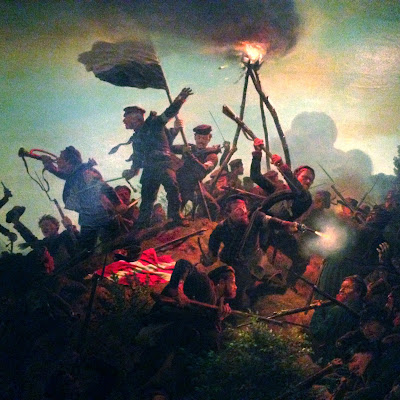Here is the logo and brand for the coming Franco-Prussian range:
Eagles of Empire Miniatures. (Logo design by French illustrator, Manu.)
Why this name? During the 19th. The seeds of democracy were swept across Europe with the winds of revolution, but so was nationalism and imperialism. All of them were factors leading to a period of immense bloodshed in World history. The Franco-Prussian War set this process in motion, with the Eagle of Imperial France posed against the Prussian Eagle, gathering all the German states under its wings.
The Churchyard in St. Privat getting stormed by Prussian guardsmen.
The Battle of Gravelotte St. Private.
The result was a united German Empire, which would shift the balance of power in Europe dramatically. A military and political landslide, that would lead the World into two “Great” wars, as young democracies battled totalitarian governments for the direction of Europe. But it was also a colourful period. One often referred to as La belle époque.
The World Exhibition in London 1851 ringing in many of the technological
discoveries that would shape the later half of the 19th. Cent.
discoveries that would shape the later half of the 19th. Cent.
It was a period of Emperors, Kaisers and Tsars. It was a time of marvellous Grand Exhibitions and fantastic technological progress. Steam powered industry gave rise to new mighty weapons, while the telegraph and railroads changed the way that wars would be lead – and won. It was a time when the old collided with the new on the battlefield.
Steam Power gave birth to the rail roads.
This would forever change the way armies and supplies moved,
and be a factor that could win wars.
and be a factor that could win wars.
I wanted a brand name that would cover all the above and span the period of 1870-1915, which is my main interest in history. I hope you will all give this new brand a warm reception.
As a further update, I can say that work on the release of the Franco-Prussian range continues. All the basics like packaging, webshop and roll-ups for the launch venue are being designed. I’ll share most of it here in previews during the coming weeks.
A parisian boulevard during "La belle époque".
Paris ca. 1900.
However, as this year draws to a close, I’d like to thank some of the people who have made this project possible:
Robert – UK based sculptor, who not only does the amazing sculpting, but who also have been a fantastic advisor on how to construct the range, to optimized it for casting.
Nick – Bavarian based hobbyist and gifted painter. Many of you know his blog already. Those of you who don’t, go have a look. I’ve been painting for more than 25 yrs, and I still find myself learning from his amazing work.
Manu – French illustrator based in Alsace. Manu has supplied all the basic artwork, and took the project on with great enthusiasm. During his work on researching the uniforms, he has been collaborating with a local Alsacian Franco-Prussian reinactor club, spilling him all the hints on how the uniforms really looked like. He has done an amazing job. More on that right here on the blog in the coming weeks.
Gustave Eiffel's tower still stands tall - and so does Paris.
Goodbye 2015 - Happy 2016 everyone!
Thank you all for your invaluable support during the work on Eagles of Empire – and a big thank you to all the blog readers, for your continued interest in my postings.
I wish you all a safe and HAPPY 2016!


















































